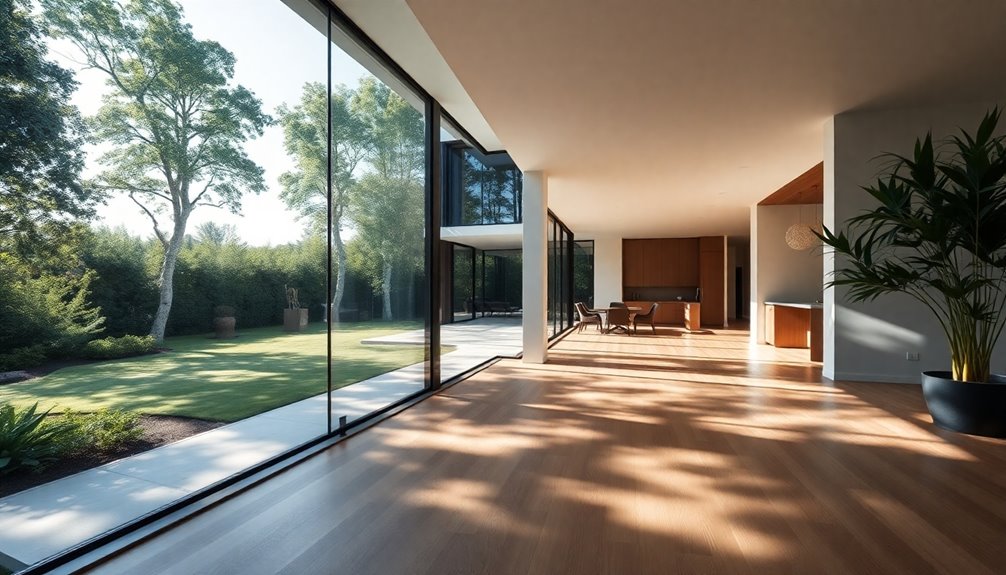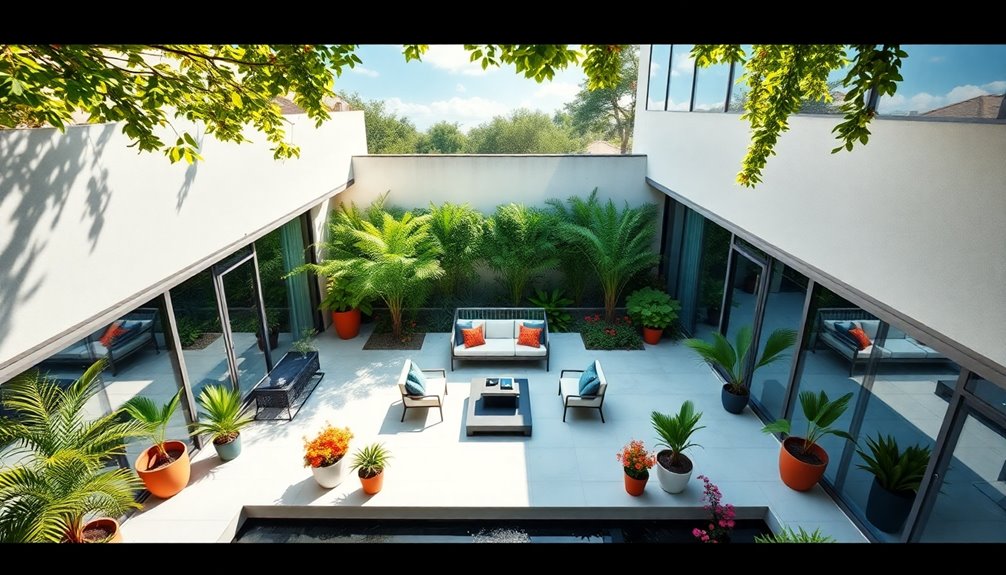Building your dream home starts with careful planning and clear communication. First, define your needs and preferences, from the number of bedrooms to design styles. Set a realistic budget, including a 10-20% contingency fund for unexpected costs. Research builders to find one with a good reputation and maintain open lines of communication throughout the process. Don't forget to take into account both current and future needs, like flexible spaces and accessibility features. Finally, stay proactive about timelines and potential delays to keep your project on track. Keep going to discover more tips that will guide you through this exciting journey.
Key Takeaways
- Clearly define your project goals and budget, including a contingency fund of 10-20% for unexpected costs.
- Research and choose a reputable builder with proper licenses, insurance, and a strong portfolio.
- Regularly monitor the construction timeline and maintain open communication with your builder to address potential delays.
- Prioritize functional design choices that cater to your lifestyle while considering future needs and resale value.
- Document your preferences and explore customizable options to ensure your home reflects your personal style and requirements.
Understanding the New Construction Process

When starting on a new construction project, understanding the process is imperative for a successful outcome. It all begins once the design is finalized, reflecting your vision and meeting local building codes. At this stage, you'll need to secure the necessary permits, which is essential for compliance.
As construction unfolds, be prepared for a lengthy building process that often exceeds initial estimates. You should anticipate a construction timeline that can stretch at least eight additional weeks beyond the projected completion date.
To navigate challenges that may arise during construction, having a contingency fund of 10-20% of your total budget is important. This fund will help cover unexpected expenses, ensuring your project stays on track financially.
Effective communication with your builders and contractors is also key. Regular updates and site visits will help you stay aligned with the building progress and address any concerns promptly. By being proactive and maintaining open lines of communication, you'll enhance the likelihood of a smooth construction experience, ultimately bringing you closer to your dream home.
Defining Your Needs and Preferences

Defining your needs and preferences is vital to creating a home that suits your lifestyle. Start by evaluating the number of bedrooms and bathrooms you'll require, along with any special features that cater to your family's unique needs. Engaging in consultations with builders can help you tailor floor plans that reflect your style and functional requirements.
Establishing a clear budget before construction begins is essential. It guides your choices and guarantees you prioritize important features over aesthetic upgrades. Don't forget to document your preferences and any changes in style over time; this will inform future upgrades and make sure your new home remains functional.
To help you visualize the process, consider the following table:
| Need | Preference |
|---|---|
| Number of Bedrooms | 3-4 bedrooms for family comfort |
| Bathrooms | At least 2 for convenience |
| Floor Plans | Open concept for spacious living |
| Budget | Set a clear limit to guide choices |
Choosing the Right Location

Finding the right location for your new build can greatly impact your overall satisfaction and investment potential. Start by considering proximity to work, schools, and shopping. This makes daily life more convenient and enhances your quality of life.
You'll want to research neighborhood safety and the community vibe, as these factors notably influence both desirability and future property values. In the Philippines, for example, understanding divorce law can be crucial for families when determining the stability of their living environment. Additionally, assessing market trends in the area can provide insights into potential property value changes. A thorough understanding of tax implications can also play a vital role in your financial planning when investing in real estate.
Investigate local amenities, like parks and recreational facilities, which can enrich your living experience. Furthermore, being aware of real estate IRAs can help you understand how your investment in property might fit into your overall retirement planning strategy.
Additionally, look into future development plans in the area. Understanding potential growth can help you gauge property value appreciation and guarantee the location aligns with your long-term goals.
Evaluating property values and market trends in different neighborhoods is essential for making an informed decision. A rising market can offer you better investment returns, while a declining area mightn't be the best choice.
Lastly, assess access to public transportation and major roads for ease of commuting, especially if you anticipate regular travel to work or other destinations. Ensuring a nurturing community environment can support children's emotional regulation and enhance overall family well-being.
Budgeting for Your New Build

When budgeting for your new build, it's crucial to set clear limits before you start working with builders.
Make sure to track your expenses diligently throughout the process to stay on target.
This way, you can avoid surprises and keep your dream home within reach.
Establish Clear Budget Limits
Establishing clear budget limits is essential for your new build, as it sets the foundation for a successful construction project. Before engaging builders, you need to establish a clear budget that covers all costs, including materials, labor, land acquisition, and permits. This approach helps you avoid overspending and guarantees financial feasibility throughout the construction process.
Consider adding a contingency fund of 10-20% to your estimated budget. This fund will help you accommodate unforeseen expenses that might arise during construction. Additionally, researching and securing financing options, like construction loans or traditional mortgages, allows you to have a solid financial base before starting the building process.
Don't forget to factor in property taxes, which may increase after the first year based on your property's improved value. By anticipating these costs, you can better manage your long-term financial planning.
Finally, tracking expenses meticulously with a detailed spreadsheet will help you prioritize spending on essential features and stay within your established budget. This disciplined approach will lead to a smoother construction experience and a home that meets both your desires and financial capabilities.
Track Expenses Diligently
Keeping a close eye on your expenses is essential for staying on track with your new build budget. To do this effectively, create a detailed spreadsheet that meticulously tracks all expenses, including materials, labor, permits, and utility connections. This will help you monitor your spending and identify areas where you can save.
Anticipate unexpected costs by setting aside a contingency fund of 10-20% of your total budget. This cushion can cover any surprises that may arise during construction, ensuring you don't derail your financial plans.
Additionally, locking in pricing upon contract signing can help mitigate the impact of market fluctuations on final home prices.
Prioritize spending on permanent features like the lot, structural options, and behind-the-wall elements. These choices greatly impact your home's long-term value.
Regularly review and update your budget as construction progresses, adjusting for any design changes or upgrades you might consider. Proper priming before painting is also crucial to ensure smooth paint flow and prevent additional costs from paint defects.
Selecting the Right Builder

When selecting the right builder, you need to research their reputation and read reviews on their completed projects.
Make sure to verify that they've the proper licenses and insurance to protect you during construction.
Finally, get detailed quotes from multiple builders to compare prices and services, ensuring you find the best fit for your new build.
Research Builder Reputation
To guarantee you select the right builder for your new construction project, it's essential to research their reputation thoroughly. Start by checking online reviews and ratings, but focus on completed projects instead of just model homes. This approach gives you a more accurate assessment of the builder's quality. Resources like the National Association of Home Builders can help you find reputable builders in your area who are licensed and insured.
Don't hesitate to request references from previous clients. Their experiences will provide valuable insights into the builder's work ethic and communication style. Pay attention to how satisfied they were with the final product and the overall process.
When you've narrowed down your options, compare detailed quotes from multiple builders. This allows you to understand pricing structures and guarantees you're getting a fair deal.
During initial meetings, assess the builder's communication style and project management approach. You want to make sure their methods align with your expectations, as clear communication is essential throughout the construction process.
Verify Licensing and Insurance
After identifying a reputable builder, it's time to confirm their licensing and insurance. First, you need to verify licensing to guarantee the builder holds all necessary permits required by your state or local jurisdiction. Building without proper licensing can lead to serious legal complications and subpar construction practices that could affect your dream home. Additionally, understanding the divorce process can help you navigate any potential legal issues that may arise during construction. In Georgia, for instance, you must meet a residency requirement of at least 6 months before filing for divorce.
Next, check their insurance coverage. Make sure they've adequate general liability and workers' compensation insurance. This protects you from potential financial liabilities arising from accidents or damages during construction. Gold IRAs can serve as a hedge against currency devaluation, providing financial stability that may help fund your new home if needed.
Request proof of the builder's insurance policy and confirm it covers any subcontractors they might hire, as this can impact your liability.
Additionally, research the builder's track record through the National Association of Home Builders or local homebuilder associations. Look for a history of successful projects and satisfied clients.
Finally, consider checking for any complaints or disciplinary actions against the builder through local regulatory boards or consumer protection agencies. This can give you valuable insight into their reputation and reliability, guaranteeing you choose a builder who'll deliver quality work on your new home. Furthermore, it is wise to consult a professional advisor to ensure that all legal aspects of hiring a builder are properly addressed.
Compare Multiple Quotes
Comparing multiple quotes is essential for selecting the right builder for your new home. Start by gathering detailed quotes from various builders to assess pricing, services, and timelines. This will help you make an informed decision based on overall value.
Don't just focus on costs; also consider the quality of materials and finishes included. Cheaper options might lead to higher long-term expenses.
Next, take the time to evaluate builders' reputations. Review online testimonials and ask for references from previous clients. This will give you insight into their reliability and craftsmanship.
Look for builders who provide clear communication plans and regular updates throughout the construction process. Effective communication is key to ensuring your project runs smoothly.
Finally, consider builders affiliated with reputable organizations like the National Association of Home Builders. This affiliation suggests they adhere to industry standards and best practices, adding an extra layer of assurance to your decision.
Design Choices and Upgrades

When it comes to making design choices and upgrades for your new build, focusing on both functionality and aesthetics is key. Start by prioritizing essential features like the number of bedrooms and bathrooms. This helps establish a layout that meets your family's needs before diving into decorative details. Additionally, consider how to maximize space and organization throughout your home to enhance both comfort and efficiency, as well as promote emotional well-being through a well-organized environment. Incorporating essential oils for relaxation in your new home can create a soothing atmosphere that contributes to overall wellness.
When considering upgrades, think about which elements will impact your daily living and home value most—kitchen cabinets and countertops are great places to splurge.
Don't forget to budget for landscaping separately. Initial landscaping is often needed within 90 days of moving in, so it's wise to plan for that expense. You might also consider deferring certain upgrades, like pool installation, to keep costs manageable.
Take advantage of the 6,000+ sqft Design Studio offered by builders like John Houston Homes. Here, you can explore customizable options, from paint colors to flooring, that reflect your personal style. Incorporating sustainable materials in your design choices can also enhance the overall value and environmental impact of your new home. You can also get inspiration and guidance from experienced interior designers who can help you maximize the potential of your new home. By taking advantage of these resources, you can easily achieve a customized and sustainable living space without the stress or guesswork. Plus, with some genius new build interior hacks, you can elevate the look and feel of your home to reflect your unique personality and lifestyle.
Document your preferences and evolving style over time; this will guide future upgrades and guarantee your design choices stay aligned with your lifestyle and aesthetic vision. By focusing on both functionality and design, you'll create a truly custom home that meets your needs.
Managing Construction Decisions

Charting the complexities of construction decisions can feel intimidating, but breaking it down into manageable steps makes the process smoother. Focus on one decision at a time to avoid feeling overwhelmed and guarantee clarity. Collaborate with your builder to understand your desired style before visiting the design center, streamlining your choices.
Here's a quick guide to help you manage construction decisions effectively:
| Step | Action |
|---|---|
| 1. Research Builders | Evaluate their actual homes built |
| 2. Collaborate | Discuss your vision with your builder |
| 3. Track Expenses | Use a detailed spreadsheet |
| 4. Prioritize Items | Focus on long-term functionality |
| 5. Communicate Regularly | Address concerns throughout the process |
Regular communication with your builder is essential for addressing concerns and guaranteeing alignment with your vision. Keep everyone informed and engaged to help build your dream home without unnecessary stress. By managing construction decisions carefully, you'll create a home that truly reflects your style and needs.
Essential Features to Consider

Choosing the essential features for your new build is crucial to creating a comfortable and functional home. Start by determining the right number of bedrooms and bathrooms based on your family's current and future needs. This guarantees everyone has adequate space, even as your family grows or changes. Additionally, consider incorporating energy-efficient systems like heat pumps to enhance your home's overall comfort and reduce long-term energy costs. Heat pumps can achieve efficiencies of 300-600%, making them a superior choice for modern homes.
Next, prioritize functionality over aesthetics. Assess necessary rooms like home offices or play areas that serve your lifestyle before diving into design elements. An open floor plan can greatly enhance the flow and connectivity between living spaces, making it a popular choice for modern families. Additionally, consider the impact of environmental factors when selecting building materials and designs that can contribute to a healthier living space.
Don't forget to take into account long-term needs. Features like wide doorways and accessible bathrooms can help future-proof your home, allowing for aging in place or accommodating guests with ease. Consider incorporating smart bathroom technologies that enhance comfort and convenience, as they can significantly elevate your daily routines.
While it's great to gather inspiration from platforms like Pinterest, make sure your design aligns with both your style preferences and functional requirements.
Communicating With Your Team

Effective communication is the backbone of a successful new build project. From the beginning, establish a clear communication plan with your builder to guarantee alignment on project goals and expectations throughout the construction process. This foundational step sets the tone for ongoing collaboration.
Schedule regular updates and site visits to address concerns and maintain open lines of communication with your contractor. This fosters a collaborative relationship where everyone feels involved and informed.
Don't forget to keep thorough records of all communications and agreements; this promotes transparency and accountability between you and your building team.
Engage in proactive discussions regarding timelines, potential delays, and budget adjustments. Staying informed and prepared for changes can save you headaches down the line.
Involving your builder in the design phase is also essential. They can provide valuable insights into costs and potential challenges, enhancing the overall efficiency of the project.
Frequently Asked Questions
How Long Does the Entire New Build Process Typically Take?
The entire new build process typically takes anywhere from six months to over a year, depending on various factors.
You'll find that the timeline can vary based on the size and complexity of the project, as well as local regulations and weather conditions.
If you stay engaged and maintain good communication with your builder, you can help keep things on track and avoid unnecessary delays during this exciting journey.
What Are Common Mistakes to Avoid When Planning a New Build?
When planning a new build, you should avoid several common mistakes.
First, don't underestimate your budget; always account for unexpected expenses.
Second, skipping thorough research on builders can lead to poor quality work.
Third, neglecting to plan for future needs might leave you with a home that doesn't fit your lifestyle later on.
Finally, remember to communicate clearly with your team to guarantee everyone's on the same page throughout the process.
How Do I Choose the Right Architect for My Project?
Choosing the right architect isn't just important; it's like picking the captain of a ship sailing through stormy seas!
Start by reviewing their portfolio—look for styles that resonate with you. Schedule interviews to get a feel for their communication skills and vision.
Ask about their experience with similar projects, and don't forget to check references. Trust your instincts; you'll want someone who shares your passion and understands your dream!
What Warranties Should I Look for With New Construction?
When you're considering new construction, look for warranties that protect your investment.
Pay attention to structural warranties, which often cover major components for ten years.
You'll also want to check for a one-year warranty on workmanship and materials.
Don't overlook systems warranties for plumbing, electrical, and HVAC, usually lasting two years.
Ascertain these warranties are transferable, so they add value if you decide to sell your home later.
Can I Live On-Site During the Construction of My New Home?
You might think living on-site during construction sounds like a great idea, but it can come with challenges.
Many builders don't allow it due to safety concerns and potential delays. You could find yourself dealing with noise, dust, and limited access to amenities.
Instead, consider finding temporary housing nearby. This way, you can keep an eye on progress while enjoying a more comfortable living situation during the construction of your new home.








